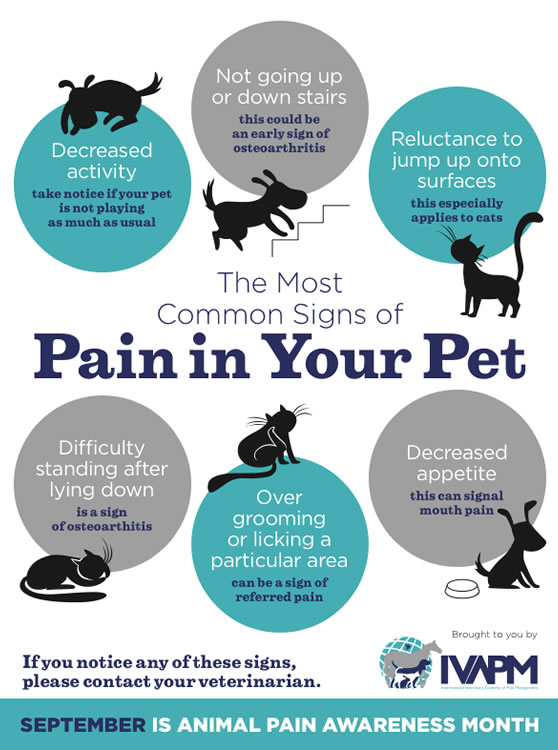As part of pet pain awareness month, we published an article earlier this month about identifying and managing pain in members of your fur family. In this second installment, we’ll share a handy infographic to help identify pain in cats and dogs and include the American Animal Hospital Association’s article summarizing its guidelines in layman’s terms.
 Pain Management Approach for Senior Companion Animals:
Pain Management Approach for Senior Companion Animals:
The Heaven at Home team takes a “multimodal” approach to helping manage pain in palliative pets. We are firm supporters of the AAHA/AAFP Pain Management Guidelines for Dogs and Cats, and subscribe to the “Continuum of Care” philosophy inherent in it. This means that pet parents and routine care veterinarians are part of the pain management planning process and that pain management should include anticipation, early intervention and evaluation.
During home visits, one of the team’s veterinarians will evaluate your pet’s condition and assess things that can be changed in the home environment to help your pet stay a part of the family. They will review records from your routine care veterinarian if available, and give you pain assessment guidelines so that you can also monitor and rate your pet’s pain behaviors. Together, we then develop a pain management plan for your pet. The plan may include a number of elements depending on the underlying cause of pain, which could be from arthritis, cancer, or any number of life-limiting illnesses.
From AAHA: 9 Things You Need to Know About AAHA’s Pain Management Guidelines:
Pets can’t tell us when something hurts—in fact, they can be experts at hiding pain. Cats are particularly adept at masking injury and illness because they instinctively hide signs of weakness from potential predators. Too often, “bad behavior” in both dogs and cats—like urinary or fecal “accidents,” aggression when handled, or refusing to follow commands to climb the stairs—actually has an underlying medical cause.
Because pain management is central to veterinary medical practice—and because there have been rapid advances in the field—AAHA collaborated with the American Association of Feline Practitioners (AAFP) to create the AAHA/AAFP Pain Management Guidelines for Dogs and Cats.
What you need to know
- Behavioral changes are the principal indicator of pain. Pay close attention to any changes in your pet’s normal behavior. For instance, what we sometimes attribute to “old age” could actually be arthritis. A cat eliminating outside the litter box might simply be because he’s unable to climb into it.
- Know the warning signs. Your dog or cat might be in pain if you notice decreased activity or appetite, lethargy, vocalization, restlessness, aggression, less interaction with pets and people, dilated pupils, or reacting with a flinch to touch in a sensitive area. Signs of pain in cats may also include flattened ears, an elongated muzzle, decreased grooming, or hiding. If you see any signs of pain, call your veterinarian.
- Reduce risk factors. You can help prevent pain with regular visits to the veterinarian for dental care and by helping them maintain a healthy weight, since decaying or otherwise damaged teeth can cause a serious toothache and obesity can lead to aching joints. Nutrition and exercise will go a long way to a healthier pet.
- If your pet is in pain, keep everyone calm. Unfortunately, pain can cause a pet to lash out at even the most well-meaning caregiver because fear and anxiety can amplify pain. Be as gentle as possible when handling your pet and speak soothingly, but also be careful not to get hurt in the process.
- Your pet may be experiencing several pathways of pain. Your veterinarian may recommend multiple pain medications to be given at the same time. That’s because pain can be controlled in many ways to decrease soft tissue, bone/joint, and nerve pain.
- There’s more to pain relief than medication. Modern veterinary medicine involves an integrated approach to pain management, not just prescribing analgesics (painkillers). Cold compression, therapy lasers, acupuncture, physical therapy, weight optimization, and adjustments to the home environment can be complementary options for alleviating pain.
- Lifestyle changes can have a huge effect on chronic pain. When a cat or dog suffers from chronic pain, changes in your home can make life easier for everyone. Soft bedding, easy access to food bowls and litter boxes, gates to limit access to stairs, and nonslip rugs can make a big difference in your pet’s day-to-day wellness.
- Your veterinary team will routinely evaluate pain at every appointment. Recording a pet’s pain score is considered the “fourth vital sign” after the standard temperature, pulse, and respiration measurements. Be sure to mention any unusual or concerning behavior.
- Pain management is a team effort. At home, you are the eyes and ears of your veterinarian, and you’re always the voice for your pet. Never overstep your role by administering pain medications meant for people or another pet, as there can be life-threatening consequences. By recognizing pain quickly and seeking treatment as soon as possible, you’ll alleviate your pet’s suffering and strengthen the bond you share.
Contact the team at Heaven at Home if you need help managing your senior pet’s pain.
